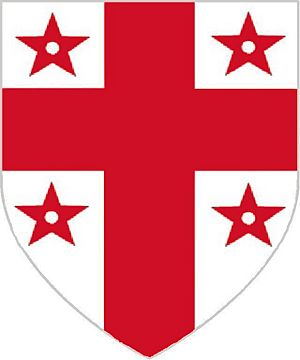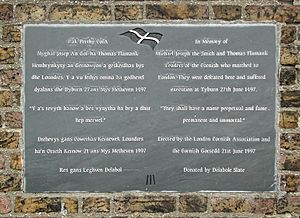Thomas Flamank facts for kids
Quick facts for kids
Thomas Flamank
|
|
|---|---|

Flamank of Boscarne: a red cross and four red stars on a silver shield.
|
|
| Died | 27 June 1497 Tower Hill, London, England
|
| Occupation | Lawyer |
| Known for | Co-leader of the Cornish Rebellion of 1497. |
Thomas Flamank was a lawyer from Cornwall, England. He lived a long time ago and died on June 27, 1497. He is famous for leading a big protest called the Cornish Rebellion of 1497. He led it with a blacksmith named Michael An Gof. They were protesting against new taxes that King Henry VII wanted to collect.
Contents
The Cornish Rebellion of 1497
In 1497, King Henry VII needed money. He wanted to send an army to Scotland because the Scottish king was helping someone who wanted to take Henry's throne. So, King Henry decided to collect a special tax from people in Cornwall.
Michael Joseph, a blacksmith from St. Keverne, was chosen by his community to speak out against this tax. When he and his supporters reached Bodmin, they met Thomas Flamank. Thomas's father was actually one of the people in charge of collecting the tax.
Thomas Flamank believed the tax was unfair and illegal. He argued that it was the job of powerful lords in the north of England to defend the Scottish border, not the people of Cornwall. He suggested that the Cornish people should march to London. There, they could tell the King about their problems. They also wanted the King to punish his advisors, like Archbishop Morton, who they thought were responsible for the unfair tax.
Marching to London
As the Cornish protesters moved into Devon, more people who agreed with them joined their cause. In Wells, a nobleman named James Tuchet, 7th Baron Audley joined them. He became their leader. The rebels marched towards London, passing through cities like Salisbury and Winchester.
People in London were very scared when they heard the rebels were coming. However, the rebels themselves started to feel discouraged. Not as many people joined them on their long march as they had hoped.
King Henry VII sent his army, led by Giles Daubeny, 8th Baron Daubeny, to stop the rebels. This army had about 8,000 soldiers.
The Battle of Blackheath
By June 16, 1497, the Cornish army, which had grown to about 9,000 people, reached Blackheath. This is an area near London. Lord Daubeny's army, along with the King and other nobles, met them there.
The next morning, a battle began at Deptford Strand. There was a fierce fight, and Lord Daubeny's troops managed to cross Deptford Bridge. They moved onto Blackheath. During the fighting, Lord Daubeny was briefly captured but quickly released.
The Cornish rebels fought bravely, but they were mostly ordinary people without proper weapons like cannons or cavalry (soldiers on horses). King Henry's army was well-trained and had much better equipment. The Cornish rebels were soon defeated and had to run away.
After the Battle
After the battle, the leaders of the rebellion faced serious consequences. Lord Audley was executed at Tower Hill. Thomas Flamank and Michael Joseph were hanged and then beheaded at a place called Tyburn on June 27, 1497. Their body parts were then displayed in different parts of London as a warning. Most of the other rebels were pardoned, meaning they were forgiven.
It is said that just before he was sentenced to death, Thomas Flamank spoke some famous last words: "Speak the Truth and only then can you be free of your chains."
Legacy
In 1997, exactly 500 years after the rebellion, a special march called "Keskerdh Kernow 500" took place. People walked the same route that the original rebels took, from St. Keverne in Cornwall all the way to London.
To remember Thomas Flamank and Michael An Gof, a statue of them was put up in St. Keverne. A special plaque was also placed on Blackheath Common in London. Another plaque was put in Guildford, where a smaller fight happened on the way to London.
Thomas Flamank was also shown as a character in a 1972 TV show called The Shadow of the Tower. He was played by actor John Castle. The show was about the time King Henry VII was in charge.
See also
- List of topics related to Cornwall
- Second Cornish Uprising of 1497
- Prayer Book Rebellion


